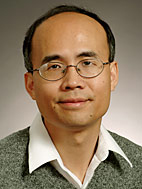Huabei Jiang, Ph.D.
Professor of Biomedical Engineering
College of Engineering
2011 Awardee
 Huabei Jiang works in the field of near-infrared diffuse optical tomography (DOT), an emerging biomedical imaging modality that can quantitatively image molecular signatures in tissue noninvasively.
Huabei Jiang works in the field of near-infrared diffuse optical tomography (DOT), an emerging biomedical imaging modality that can quantitatively image molecular signatures in tissue noninvasively. He is playing a pivotal role in pushing this field forward and has developed a revolutionary technique for early detection of breast cancer using DOT. He was the first to apply DOT to imaging bone and joints, which has now become an important and rapidly growing sub-field in optical imaging.
Jiang made pioneering contributions to the development of quantitative photoacoustic tomography (PAT). He was also the first to experimentally demonstrate bioluminescence tomography, which is useful for monitoring gene therapy and drug delivery. He invented phase-contrast diffuse optical tomography which has opened a new direction for the field of DOT. Jiang has also made important contributions to fluorescence tomography for molecular imaging. He was the first to implement a finite element reconstruction algorithm which has now become the most popular/dominant method in his field.
Jiang continues to discover and explore alternative biomedical imaging methods using visible/near-infrared light, microwave, x-ray, and ultrasound. He and his colleagues develop advanced computational methods for inverse problems, construct complex or simple imaging hardware, and perform laboratory, pre-clinical, and clinical experiments.
His current research interests include the development and optimization of diffuse optical tomography, fluorescence molecular tomography, photoacoustic tomography, microwave tomography, and electromagnetic wave-induced thermoacoustic tomography for a variety of pre-clinical and clinical applications including breast cancer detection, cancer margin identification, monitoring of cancer therapy, epilepsy localization, osteoarthritis diagnosis, and noninvasive study of neuro-vascular and neuro-cellular coupling.

